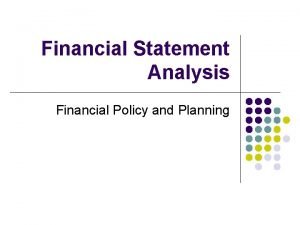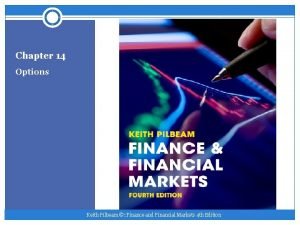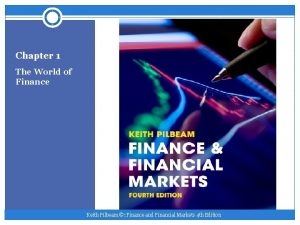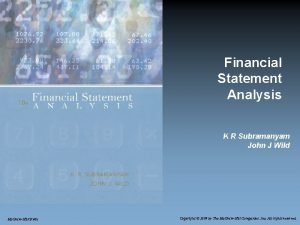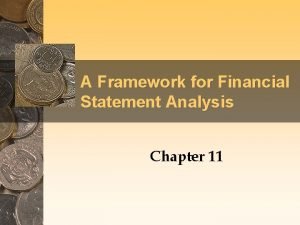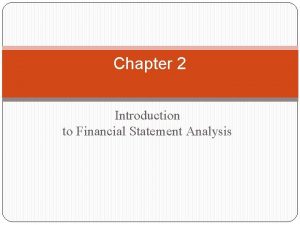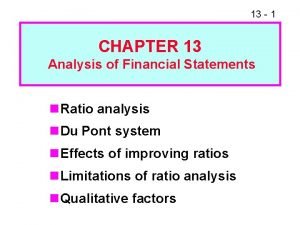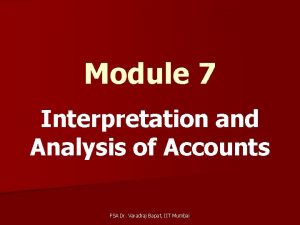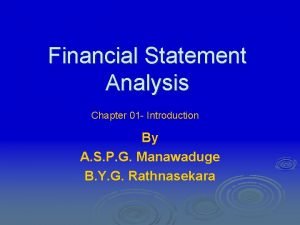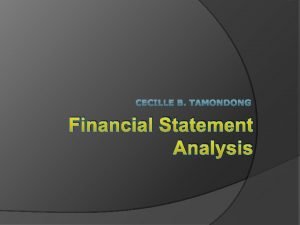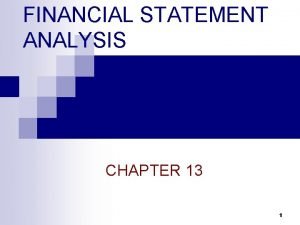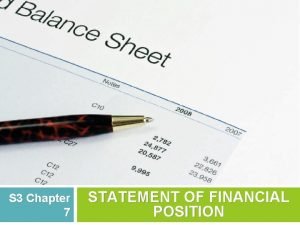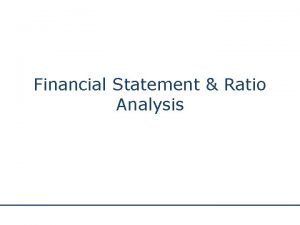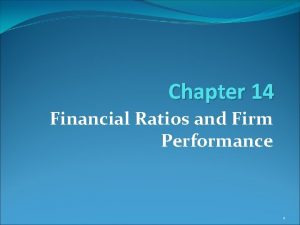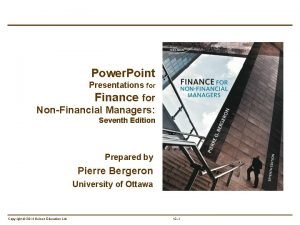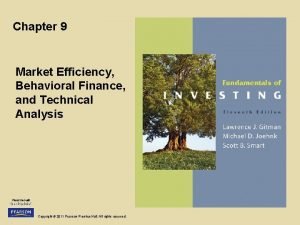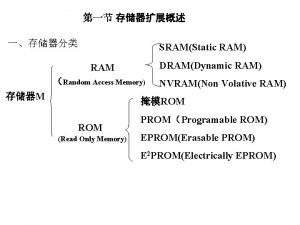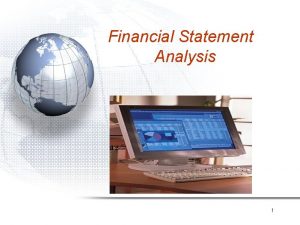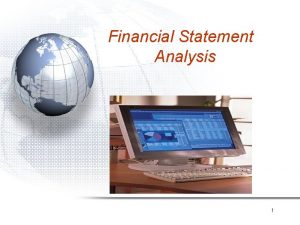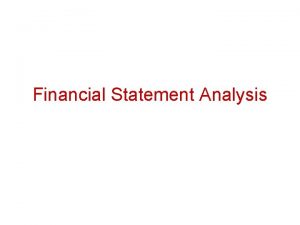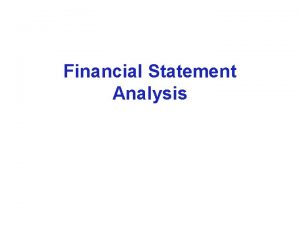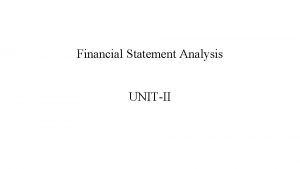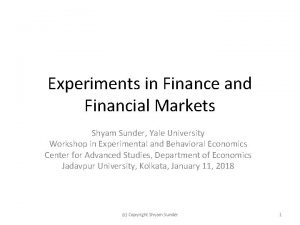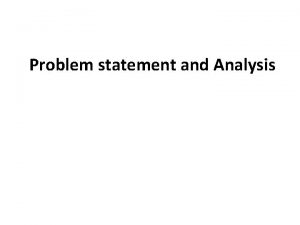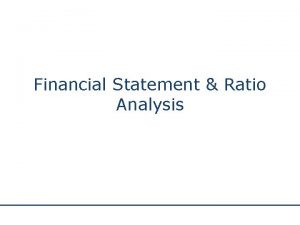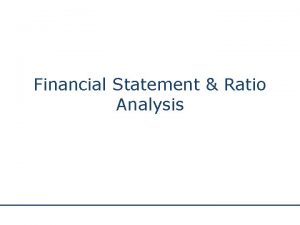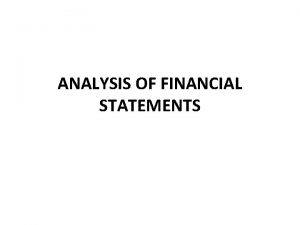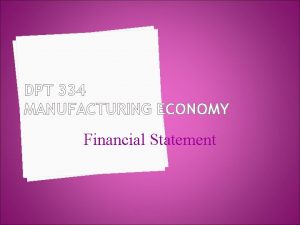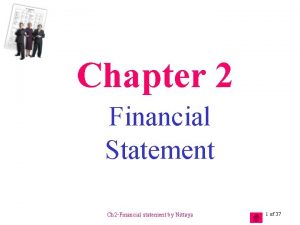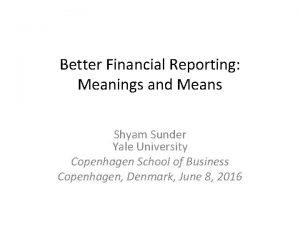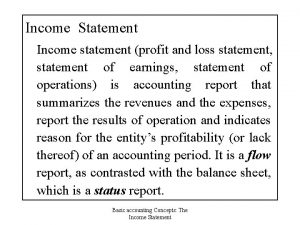Finance and Financial Statement Analysis Sunder Ram Korivi























- Slides: 23

Finance and Financial Statement Analysis Sunder Ram Korivi National Institute of Securities Markets

Agenda • Concepts of Finance • Decisions in Finance • Financial Markets • Securities Markets • Assets, Liabilities, Income, Expenses • Capital Structure Analysis • Credit Analysis • Cash Flow Analysis

Finance is the short name for Financial Economics is a branch of Economics Youngest but one of the fastest growing branches Has been recognized through Economics Nobel awards: Harry Markowitz, James Tobin, Franco Modigliani, Merton Miller, William Sharpe, Eugene Fama, Robert Shiller, Myron Scholes, Robert Merton. • Financial Economics has four sub-components • (1) Corporate Finance, (2) Investment Theory, (3) Portfolio Theory, (4) Financial Institutions & Markets • The four compartments are inter-connected and have an intense influence on valuation. Fama-Miller framework of asset pricing; dimensions of time and risk • •

Finance Quiz • Which is the oldest bank in the world? • What is the origin of the word ‘bankrupt”? • Oldest insurer in the world? • Which is the oldest company in the world? • Did the company form of organization evolve in one step? • Did the primary market and secondary market evolve separately? • How did the bond markets evolve? • Where did the mortgage markets evolve?

The Ascent of Money by Niall Ferguson • Oldest bank - Siena : Monte de Piachi • Oldest insurer: Lloyds Coffee House on Tower Street, London • Oldest company: Dutch East India Company, VOC, Amsterdam • French Government Bond Market • Danish Pfandbrief

Markets • Financial Market • Securities Market • Capital Market • Money Market • Primary Market • Secondary Market • Commodity Market • Derivative Market

Corporate Finance • Goal • Decisions to be made

Ezra Solomon, 1952 • Goal: Shareholders’ Wealth Maximization • Decisions: • Investment Decision • Financing Decision • Dividend Decision

More questions • Why do we organize business as a firm? • Why does a firm need to grow?

How is value created? • Accounting information • Market information • Value Creation Model, with examples

Income Statement • • • Sales Other Income - Material Costs Employee Costs Other Operating Costs - Depreciation & Amortization - Interest & Financial Charges = PBT - Income Tax = PAT / S (No of Shares) = EPS

Income Statement • • Sales - Variable Costs = Contribution - Fixed Costs, including Depreciation & Amortization = EBIT - Interest & Financial Charges = PBT • Risk can come from leverage

Income Statement (Contd) • EBIT • - Interest • = PBT • - Income Tax • = PAT • / S (No. of Shaares) • = EPS • Financial leverage and taxes have an offsetting impact

EBIT-EPS Analysis • EBIT • - Interest • = EBIT – Interest • - Taxes • = (EBIT – Interest) (1 -t) • EPS = [(EBIT – Interest) (1 -t)]/S

Adjustments • • • Accruals Non-cash charges Other non-operating income Non-recurring income Maintainable expenses Segment results Related party transactions End of period adjustments (Quadrophobia); D/E not known Need to correlate with macro data; turning points.

Balance Sheet • Share Capital • Reserves & Surplus • Long Term Debt / Instruments? • Short Term Debt / Instruments? • Contingent Liabilities • Related party transactions

Balance Sheet • Fixed Assets (Net of Depreciation) • Investments: Strategic and Liquid • Current Assets: Inventories, Receivables, Pre-paids, Advances, Cash • Current Liabilities: Payables, Provisions, Statutory Dues • Net Current Assets • Deferred Revenue Expenditure • Related party transactions •

Balance Sheet Liabilities Assets • Share Capital • Reserves & Surplus • = Net Worth • Fixed Assets • Investments • Current Assets – Current Liabilities • Long Term Debt • Capital Employed • Total Assets

Cash Flow Statement • Cash from Operations • Cash for Investment Activities • Cash from Financing Activities • Opening Balance • Closing Balance Analysis: • OCF / Sales • OCF / Total Assets

Du Pont Analysis • PAT/PBIT (Financial Performance) • PBIT/Sales (Margin) • Sales/TA (Volume) • TA/Long Term Debt (Coverage) • Long Term Debt/Equity (Leverage)

Credit Perspective • Interest Coverage Ratio • Debt Service Coverage Ratio • Debt/Equity Ratio • Total Liabilities/Equity Ratio

Equity Perspective • P/E • P/B • D/E • Dividend Yield

Concluding Remarks • Due Diligence Review: Business, Financial, Technical, Legal • Look at firms as a going concern • Low P/E and Low P/B may provide ominous signals • High P/E and High P/E may signal froth
 Ram nam me lin hai dekhat sabme ram
Ram nam me lin hai dekhat sabme ram Shyam sunder meaning
Shyam sunder meaning Financial statement analysis and planning
Financial statement analysis and planning Pilbeam k. finance and financial markets
Pilbeam k. finance and financial markets Keith pilbeam
Keith pilbeam Chapter 14 financial statement analysis solutions
Chapter 14 financial statement analysis solutions Kr subramanyam
Kr subramanyam Chapter 14 financial statement analysis solutions
Chapter 14 financial statement analysis solutions Financial analysis framework
Financial analysis framework Financial statement analysis chapter 2 solutions
Financial statement analysis chapter 2 solutions Objectives of financial statement analysis
Objectives of financial statement analysis Chapter 13 financial statement analysis
Chapter 13 financial statement analysis Horizontal analysis interpretation
Horizontal analysis interpretation Introduction of financial statement analysis
Introduction of financial statement analysis Financial analysis for banks
Financial analysis for banks Solvency investopedia
Solvency investopedia Chapter 13 financial statement analysis
Chapter 13 financial statement analysis Internal users of financial reports
Internal users of financial reports Chapter 1 overview of financial statement analysis
Chapter 1 overview of financial statement analysis Average payment period ratio
Average payment period ratio Chapter 14 financial statement analysis
Chapter 14 financial statement analysis Neton
Neton Financial method of motivation
Financial method of motivation Odd-lot trading indicator
Odd-lot trading indicator


